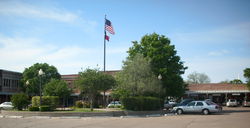Lancaster, Texas
| Lancaster, Texas | |
|---|---|
| City | |

Lancaster's Historic Town Square
|
|
| Nickname(s): The City of Trees | |
 Location of Lancaster in Dallas County, Texas |
|
| Coordinates: 32°36′8″N 96°46′30″W / 32.60222°N 96.77500°WCoordinates: 32°36′8″N 96°46′30″W / 32.60222°N 96.77500°W | |
| Country |
|
| State |
|
| County | Dallas |
| Government | |
| • Type | Council-Manager |
| • City Council |
Mayor Marcus Knight Carol Strain-Burk Stanley Jaglowski Marco Mejia Spencer Hervey, Jr. Clyde Hairston Nina Morris |
| • City Manager | Opal Mauldin Robertson |
| Area | |
| • Total | 30.3 sq mi (78.6 km2) |
| • Land | 30.3 sq mi (78.4 km2) |
| • Water | 0.08 sq mi (0.2 km2) |
| Elevation | 522 ft (159 m) |
| Population (2015) | |
| • Total | 38,801 |
| • Density | 1,300/sq mi (490/km2) |
| Time zone | Central (UTC-6) |
| • Summer (DST) | Central (UTC-5) |
| ZIP codes | 75134, 75146 |
| Area code(s) | 214, 469, 972 |
| FIPS code | 48-41212 |
| GNIS feature ID | 1339599 |
| Website | Lancaster-TX.com |
Lancaster (/ˈlæŋkɪstər/ LANG-kiss-tər ) is a city in Dallas County, Texas, United States. The population was 36,361 at the 2010 census. Founded in 1852 as a frontier post, Lancaster is one of Dallas County's earliest settlements. Today, it is a suburban community located in the Dallas-Fort Worth Metroplex, approximately 15 miles (24 km) south of Downtown Dallas.
Lancaster is part of the Best Southwest area, which includes Lancaster, Cedar Hill, DeSoto, and Duncanville.
In 1841, an act of the Republic of Texas Congress authorized President Mirabeau Lamar to enter into a contract with William S. Peters and nineteen associates to promote settlement in North Texas and paid the company with free land in exchange for recruiting new settlers. Around 600 families would settle in what became known as Peters Colony from 1841 through 1844. The Peters' group advertised heavily in Kentucky, Illinois, Missouri, and Tennessee, and for that reason, many of the earliest settlers were from those states. The first group to settle in the Lancaster area was Roderick Rawlins and his family from Greene County, Illinois. They left for Texas in September 1844. Rawlins and two of his sons-in-law came ahead to select the general area where they would settle. They chose an uninhabited area south of Dallas along the north bank of Ten Mile Creek as the site of their new settlement. In December 1844, the three men went back to Lamar County near the Red River to bring the rest of their wagon train. All of the settlers had arrived by January 2, 1845 and they formed a community known as Hardscrabble. It consisted of two rows of log cabins with a street running north and south. In total, 30 men, women, and children lived in Hardscrabble.
...
Wikipedia
